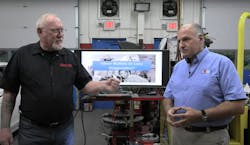What are the top 12 most common diagnostic trouble codes (DTCs)?
Pete Meier, technical editor at Motor Age, and G. Truglia of Technicians Service Training (TST) hosted a webinar last week where they revealed the top 12 diagnostic trouble codes (DTCs) based on their research from various service information databases.
P0420/P0430 – Catalyst system low efficiency
Meier and Truglia also revealed the top 10 repairs.
Top 10 repairs
1. Replace catalytic converter (with OE)
2. Replace oxygen sensor
3. Replace ignition coils and spark plugs
4. Replace mass air flow sensor
5. Inspect for loose fuel cap – tighten or replace as necessary
6. Replace ignition coils
7. Replace EVAP purge valve
8. Replace fuel injectors
9. Replace thermostat
10. Replace EVAP purge control valve.
Given some discrepancies between the tops DTCs and the top repairs, Meier encouraged viewers to think like detectives before jumping to a conclusion about a repair. For starters, everyone — well, everything — is a suspect.
“When you have a problem with a car, starting off, every part in the car is suspect. I don’t want you to say ‘I know for sure it can’t be X,’ but you didn’t verify that or confirm that; you just assumed that.”
The next step is to eliminate them by group. Technicians need to go through the service information and learn how that component or system works, how it interfaces with other systems on the car, and learn everything they can. Then they can eliminate the remainder one by one by conducting specific tests for each component and isolating them until they find the problem.
“Today, close enough, is not good enough," Meier said. "Today’s vehicles are high technology, highly complicated, and designed to work in a very narrow range. You have to be spot-on with your repairs. You’ve got to do your homework.”
Missed the live webinar? Don't worry, you can still access it for free here: https://events.motoragetraining.com/products/Top-10-DTCs.aspx.

